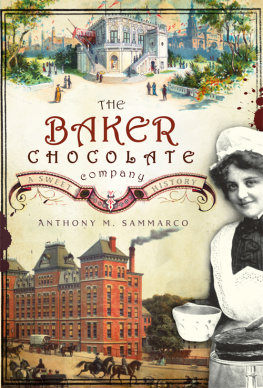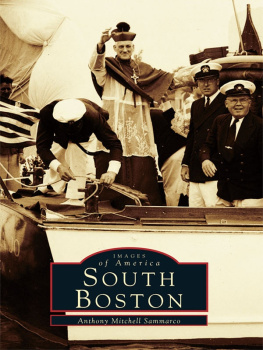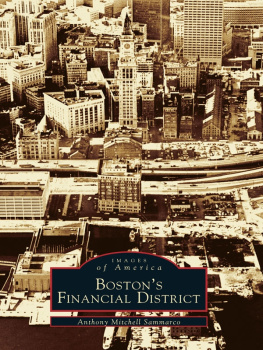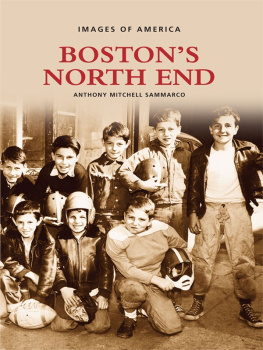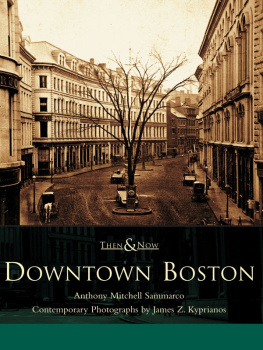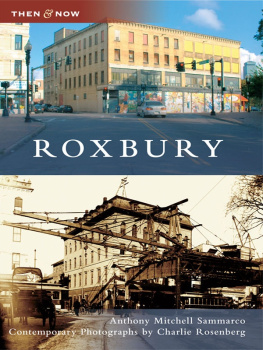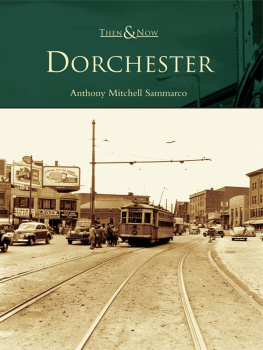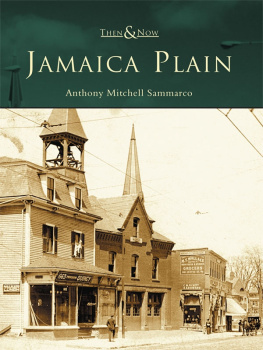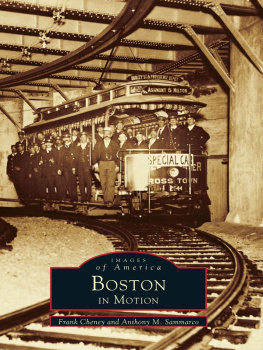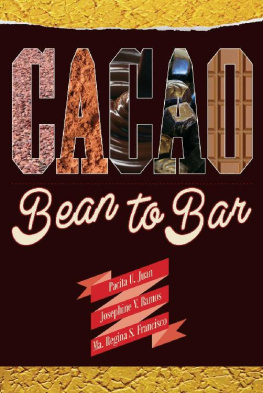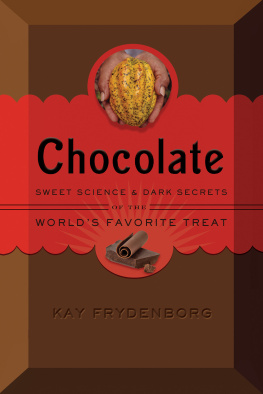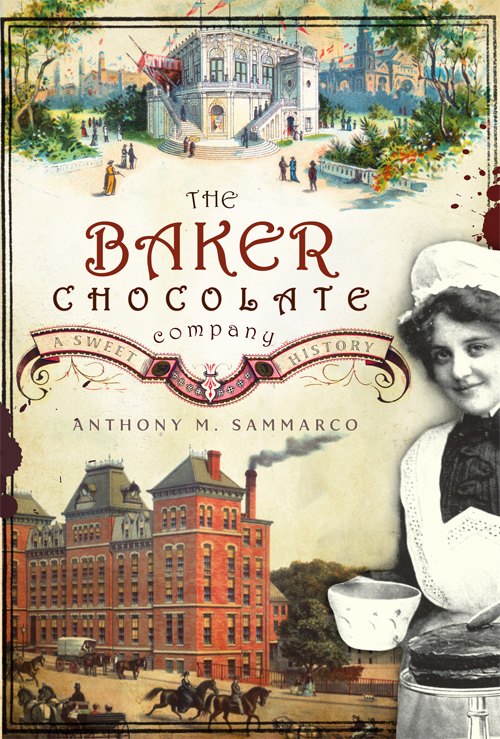Looking east from Eliot Street in Milton Village, the Pierce Mill can be seen in the center distance, with wood mills along both sides of the Neponset River. Courtesy of Earl Taylor.
ANTHONY M. SAMMARCO
Unless otherwise noted, illustrations are from the collection of the author.
Sammarco, Anthony Mitchell.
The Baker Chocolate Company : a sweet history / Anthony Sammarco.
p. cm.
Includes bibliographical references.
print edition ISBN 978-1-59629-353-3
1. Baker Chocolate Company (Dorchester (Boston, Mass.)) 2. Chocolate industry--Massachusetts--Boston--Dorcester--History. 3. Businesspeople--United States-
Biography. I. Title.
HD9200.U54.B357 2009
338.76645--dc22
2009033691
All rights reserved. No part of this book may be reproduced or transmitted in any form whatsoever without prior written permission from the publisher except in the case of brief quotations embodied in critical articles and reviews.
ACKNOWLEDGEMENTS
Chocolate is a mysterious yet sublimely delicious substance. It was a drink before it became a delicacy, a food before it became a delicious treat.
There have been many people who assisted me in the research and writing of this book on a very delicious memory from the past; however, I would like to especially thank Andy Sawicky for sharing his time, expertise, knowledge and, with the loan of some interesting advertisements, pieces of ephemera and photographs from his collection of Baker Chocolate memorabilia used in this book. I would also like to thank Anne Flanagan Thompson for the use of her research material, conversations and sharing her unbounded enthusiasm for all things Baker. Without the assistance, immense patience and unflagging support of Cesidio Joe Cedrone, this book would never have been completed, and I dedicate this book to him.
I would also like to offer sincere thanks to Donald and Cynthia Agnetta; the residents of Baker Square Condominiums; Donald Blair; the Boston Public Library, Print Room, Aaron Schmidt; Helen Buchanan; the late Paul G. Buchanan; Judith Reed Emmons Bullock; Sean Cahill; Mary Jo Campbell; Cedar Grove Cemetery; the late Donato Cedrone-Sammarco; Elise Ciregna and Stephen LoPiccolo; Edith G. Clifford; Regina Clifton; Elizabeth Curtiss; the Dallas, Texas Public Library, Rachel Garrett Howell; William Dillon; the Dorchester Community News; Mike Doyle; Jean Dudley; Olivia Grant Dybing; the marvelous world of eBay; the late Dr. Lydia Bowman Edwards; the late A. Bradlee Emmons; the late Joan Estelle Evans; William Fall; Robert Fitzgerald; Captain Forbes House Museum, Christine Sullivan, director; Russell Fox; Jean Goldman and Vincent DaForno; Edward Gordon; Helen Hannon; Historic Burying Ground Initiative, city of Boston; Historic New England, Lorna Condon; James Hobin; Chuck and Pam Huckins; Hutchinson; Peter Jackson and Donna Dickerson; Stephen Kharfen; James Z. Kyprianos; Nadine Leary; Jane S. Lemire; Tim Lemire; Paul Leo; Joseph LoPiccolo; Judith McGillicuddy; Karen L. Mac Nutt Esq.; Milton Cemetery, Therese Desmond Sills; Mittens; Mount Auburn Cemetery, Janet Hayward; Frank Norton; Ellen Ochs; Stephen ODonnell; Susan W. Paine; the late Stephen Davies Paine; James Pardy; Frances Perkins and Charlie Rosenberg; Jeannette Lithgow Peverly; Loretta Philbrook; Mark Pickering; Museum of Fine Arts, Boston, Erin Schleigh; Linda Mason Pirie, president of the Milton Historical Society; Steven Pirie; Elva Proctor; Lilian M.C. Randall; Kita Reece; Margaret Recanzone; Saunders Robinson, my editor; Nina and Anthony Salvucci; Carolyn Savage; Robert Bayard Severy; Staatliche Kunstsammlungen, Dresden, Germany, Yvonne Brandt; Jeanne Sutton; Earl Taylor, president of the Dorchester Historical Society; Anne and George Thompson; Carolyn D. Thornton; Archives and Special Collections, Healey Library, University of Massachusetts Boston, Elizabeth Mock; the Urban College of Boston; Peter Van Delft; the Victorian Society, New England Chapter; Steven Walker, South End Photo Lab; Ann and Thomas Walsh; Wikipedia, the Free Encyclopedia; the late Marion White Woodbridge; Monica Woodbridge; Virginia M. White; and James Preston Wysong.
However, per the specific request of Mary A. Carragher Esq., attorney for Kraft Foods, the successor in interest to the Walter Baker Chocolate Company and owner of the Bakers Chocolate trademark and La Belle Chocolatiere design trademark, Kraft Foods wished to state that it does not authorize, endorse or sponsor this book and was in no way affiliated with it. Nor did they offer any cooperation or assistance.
INTRODUCTION
If the Chocolate does not prove good, the Money will be returned.
The Lower Mills, known by the Neponset Tribe of the Massachusetts Indians as Unquety, meaning Lower Falls in Algonquin, is in Dorchester, Massachusetts, and is the site of the first gristmill in New England (1634), the first powder mill in New England (1665), the first iron slitting mill (1710), the first paper mill in New England (1728), the first chocolate mill in America (1765), the first folio and quarto letter paper in New England (1803) and the first power-sawn veneers in America (1817). By the time of the Civil War, the Lower Mills, which encompasses the towns of Dorchester and Milton, Massachusetts, but is known as Milton Village south of the Neponset River, was made up of commercial concerns that once employed close to one thousand people. There were once four independent chocolate manufacturers in the Lower Mills, with the Baker, Preston, Dr. Jonathan Ware and Webb & Twombley Chocolate Companies producing so much chocolate that the pervasive and heady aroma led to the area being called Chocolate Village. Though a few of the commercial concerns continued into the twentieth century, by 1881, the competitive chocolate manufacturers were all to be absorbed by the Baker Chocolate Company, the oldest manufacturer of chocolate in this country. Chocolate was one of the most deliciously prolific, as well as profitable, concerns developed since the introduction of the cacao to the colonies in the mid-eighteenth century.
In 1765, as tradition has it, Dr. James Baker (17391825) of Dorchester met John Hannon, a penniless Irish immigrant, crying on the banks of the Neponset River. Inquiring as to his obvious distress, Baker learned that Hannon was destitute but that he possessed the skill of making chocolate, having learned it in England. As chocolate and cocoa were not only delicious commodities but also fashionable extravagances imported from Europe, Baker financially backed Hannon in a leased, small, wood-framed mill in Milton Village, where Hannons Best Chocolate was manufactured for almost fifteen years, with an incredible guaranteed money-back policy that stated, If the Chocolate does not prove good, the Money will be returned. In 1779, Hannon is said to have sailed to the West Indies, according to the town history, to purchase cacao beans, but the ungallant rumor was that he deserted his shrewlike wife, Elizabeth Gore Hannon. Whatever his reason for leaving, he never returned. After hiring Nathaniel Blake to carry on the chocolate business, a year after her husbands departure, the Widow Hannon, who was remarried in 1782 to William Walker, sold her share of the enterprise to Dr. James Baker, who established the Baker Chocolate Company in 1780.

